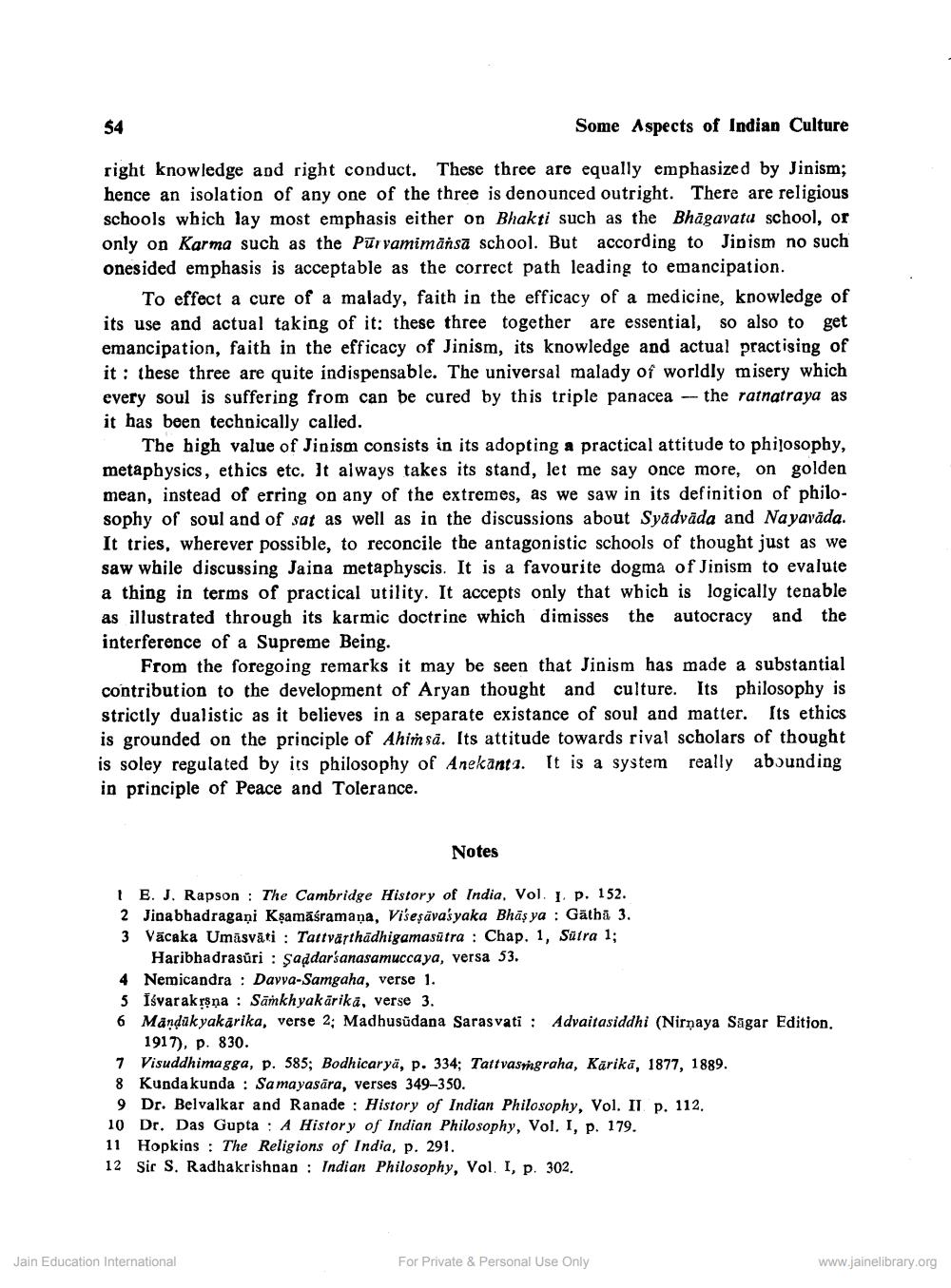________________
54
Some Aspects of Indian Culture
right knowledge and right conduct. These three are equally emphasized by Jinism; hence an isolation of any one of the three is denounced outright. There are religious schools which lay most emphasis either op Bhakti such as the Bhāgavata school, or only on Karma such as the Pūrvamimänsa school. But according to Jipism no such onesided emphasis is acceptable as the correct path leading to emancipation.
To effect a cure of a malady, faith in the efficacy of a medicine, knowledge of its use and actual taking of it: these three together are essential, so also to get emancipation, faith in the efficacy of Jinism, its knowledge and actual practising of it : these three are quite indispensable. The universal malady of worldly misery which every soul is suffering from can be cured by this triple panacea - the ratnatraya as it has been technically called.
The high value of Jinism consists in its adopting a practical attitude to philosophy, metaphysics, ethics etc. It always takes its stand, let me say once more, on golden mean, instead of erring on any of the extremes, as we saw in its definition of philosophy of soul and of sat as well as in the discussions about Syadvāda and Nayavada. It tries, wherever possible, to reconcile the antagonistic schools of thought just as we saw while discussing Jaina metaphyscis. It is a favourite dogma of Jinism to evalute a thing in terms of practical utility. It accepts only that which is logically tenable as illustrated through its karmic doctrine which dimisses the autocracy and the interference of a Supreme Being.
From the foregoing remarks it may be seen that Jinism has made a substantial contribution to the development of Aryan thought and culture. Its philosophy is strictly dualistic as it believes in a separate existance of soul and matter. Its ethics is grounded on the principle of Ahimsa. Its attitude towards rival scholars of thought is soley regulated by its philosophy of Anekanta. It is a system really abounding in principle of Peace and Tolerance.
Notes
| E. J. Rapson : The Cambridge History of India, Vol. 1 p. 152. 2 Jinabhadragani Kşamasramana, Visesävasyaka Bhas ya : Gätha 3. 3 Vācaka Umāsvāti : Tattvärthādhigamasutra : Chap. 1, Sūtra 1;
Haribhadrasüri : Saddarsanasamuccaya, versa 53. 4 Nemicandra : Davva-Samgaha, verse 1. 5 Isvarakrsna : Samkhyakārikā, verse 3. 6 Manduk yakarika, verse 2: Madhusudana Sarasvati : Advaitasiddhi (Nirnaya Sagar Edition.
1917), p. 830. 7 Visuddhimagga, p. 585; Bodhicarya, p. 334; Tattvasmgraha, Kärikā, 1877, 1889. 8 Kunda kunda : Samayasāra, verses 349-350. 9 Dr. Belvalkar and Ranade : History of Indian Philosophy, Vol. II p. 112. 10 Dr. Das Gupta : A History of Indian Philosophy, Vol. I, p. 179. 11 Hopkins : The Religions of India, p. 291. 12 Sic S. Radhakrishnan : Indian Philosophy, Vol. I, p. 302.
Jain Education International
For Private & Personal Use Only
www.jainelibrary.org




